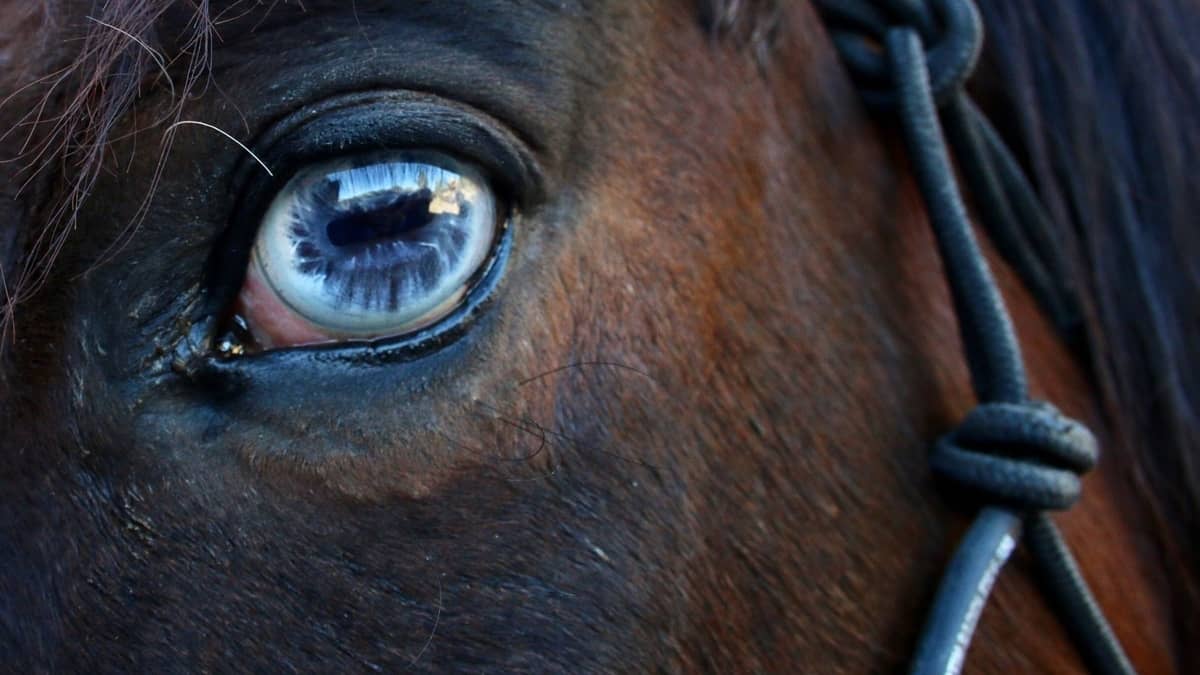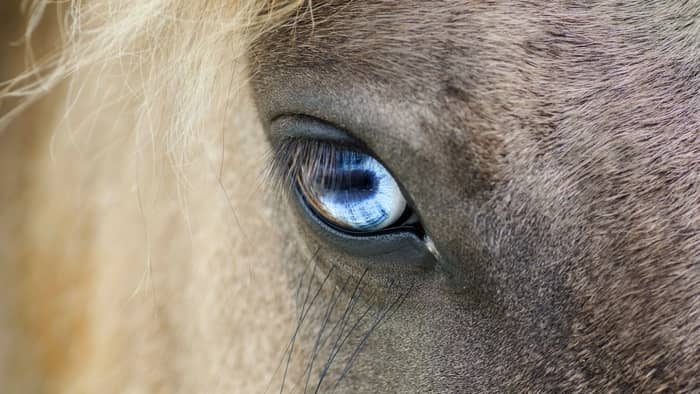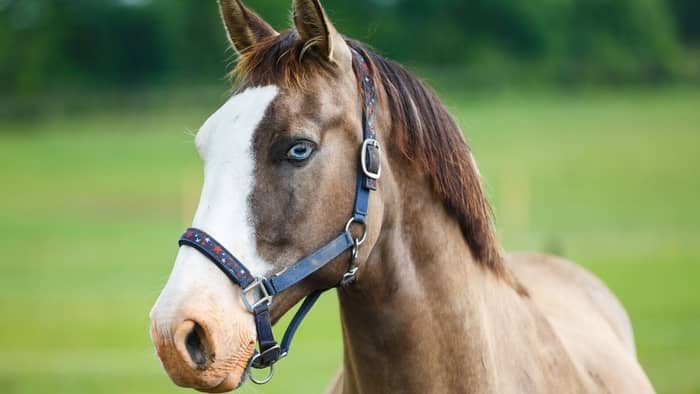Last Updated on February 23, 2022 by Griselda M.
If you’ve ever seen a horse with blue eyes, you might be wondering how they get this unusual coloring. Horses with blue eyes are not very common, although they are more prevalent in some horse breeds than others. Let’s find out everything you need to know about this unusual quirk of horse coloring!
Why Do Some Horses Have Blue Eyes?
The most common eye color in horses by far is brown eyes. This coloring occurs as a result of pigmentation of the tissues of the eye and surrounding areas.
When a horse appears to have blue eyes, it actually has no pigmentation at all. What we are seeing is the structure of the eye without any color applied.
Whether a horse has blue or brown eyes will depend on the color genes it inherits from its parents. All horses have a base coat color of either black, chestnut, or bay; this is then altered by other genes that lighten the color or create patterned markings.
So, this means that all horses will have brown eyes unless a specific set of color-changing genes are passed on from the dam or the sire. These genes will lighten the brown pigment to the point that it disappears, leaving the eye with a blue appearance.
Read more about Navicular Disease In Horse Explained!
How Do You Get A Horse With Blue Eyes?
There are certain coat colors and markings that make the likelihood of blue eyes much greater. The main examples are horses with cremello coloring, and horses with paint markings. A horse with large white patches on its face is also more likely to have blue eyes.
Cremello horses with blue eyes
A horse with cremello coat coloring is highly likely to have blue eyes. In this example, it is normal for both eyes to be blue.
Cremello coat coloring occurs when a horse is born with a chestnut base coat color and inherits two copies of the cream coat color dilution gene. This gives an extreme lightning effect to the coat, removing almost all of the pigmentation. The result is a cream-colored horse with blue eyes.
Other less common examples of horses with blue eyes are those with perlino coloring. This is a horse with a bay base coat color, and two copies of the cream coat color dilution gene.
Paint horses with blue eyes
Horses that carry a white spotting pattern gene are more likely to have blue eyes. White spotting pattern genes create areas of white on the horse’s coat, either in large patches or small spots. This can create the distinctive white patches we see in Paint horses or delicate spotting on the coat of an Appaloosa.
Other horses with blue eyes
If a horse has white markings on the face which extend beyond the margin of the eye, it may also have blue eyes. These types of markings are more common in horses with white spotting pattern coloring, such as overo horses. However, a horse with a solid body color can also have blue eyes if it has an extensive white face marking.
Which Horse Breeds Have Blue Eyes?
Horse breeds with higher numbers of blue-eyed horses include those that have a high number of horses carrying the cream coat color dilution gene. Blue eyes are also common in horse breeds that are more likely to have white spotting pattern genes.
So, if we are looking for blue-eyed horses, the best breeds to go for are American Quarter Horses, Pintos, Appaloosas, and Paint Horses. Tennessee Walking Horses and Gypsy Vanners also have high numbers of blue-eyed horses amongst their population.
Some horse breeds are highly unlikely to have blue eyes, as they do not carry the genes to create this particular coloring. It is very unusual to find breeds such as the Thoroughbred, Arabian, or Morgan horse with blue eyes.
Do Horses Have Any Other Eye Colors?
The most common eye color in horses is brown, with blue eyes coming second. However, in some very rare instances, you may see a horse with a gray, light green, yellow, or violet tinge to its eye.
These colors are a lighter shade of the brown eye color and only occur under a specific set of genetic influences. It is incredibly unusual to find a horse with these eye colors, and they are often highly sought after!
Summary
So, as we have learned, a horse with blue eyes is the result of the genes that create the coat color of a horse. Horses with blue eyes are more common in breeds that have a high proportion of horses with the cream color dilution gene, or white spotting pattern genes. This unusual eye color is the result of a lack of pigmentation in the eye.
We’d love to hear your thoughts on horses with blue eyes! Have you ever owned a horse with blue eyes? Or do you have any questions about how to care for a horse with blue eyes? Leave a comment below and we’ll get back to you!
Learn more about Horse With Dog Teeth; Equine Dentistry Explained!
FAQs
What Is A Horse With Blue Eyes Called?
A horse with blue eyes is referred to as having wall eyes. Horses can either have one blue eye and one brown eye, or two blue eyes.
Why Horse With Blue Eyes?
The color of a horse's eye are determined by the color genetics of the horse. Some colors of horse and types of markings are more likely to result in a horse with blue eyes.
How Rare Is A Horse With Blue Eyes?
The prevalence of horses with blue eyes depends on the breed of the horse. Some horse breeds have many blue-eyed horses, while in other breeds it can be very rare to get a horse with blue eyes. Blue eyed horses are most common in breeds that have certain coat colors.
Do Horses With Blue Eyes Go Blind?
Horses with blue eyes are more likely to develop a disorder called ocular squamous cell carcinoma than horses with brown eyes. This affects the eyes and eyelids of the horse, and can lead to blindness.


